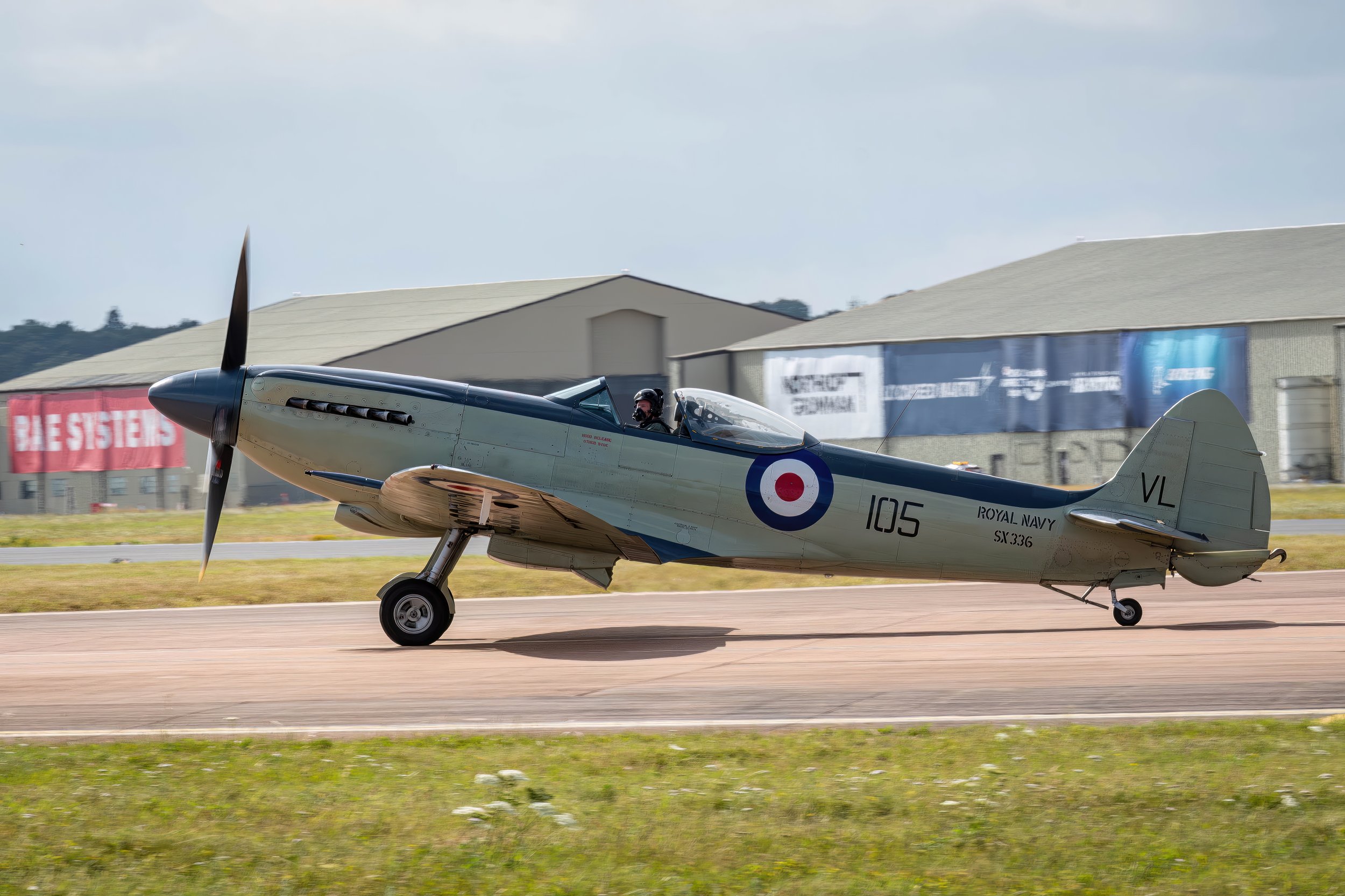
January 7 / Supermarine Seafire first flight
First Flight 7 January 1942
Supermarine Seafire
The Supermarine Seafire, a navalized variant of the renowned Supermarine Spitfire, has a history deeply intertwined with the evolution of naval aviation during World War II and the immediate post-war years. The origins of the Seafire can be traced back to the late 1930s, a time when the British Admiralty recognized the pressing need for a modern fighter aircraft capable of operating from aircraft carriers. In May 1938, the Admiralty proposed the development of a carrier-capable version of the Spitfire, which had already gained fame for its performance during the Battle of Britain.
However, the proposal faced significant opposition. Influential figures, including Winston Churchill, were more focused on ensuring that land-based Spitfires were produced in sufficient numbers to defend Britain from aerial attacks. This internal conflict within the British military leadership highlighted the challenges of resource allocation during a time of escalating global tensions. Despite these obstacles, the Admiralty persisted in its quest for a navalized Spitfire, and by late 1941, the first batch of Seafire Mk.Ib fighters was produced. These early models were primarily intended for experimentation, allowing the Fleet Air Arm (FAA) to gain valuable experience in operating a navalized version of the Spitfire.
The initial Seafires, however, were not without their challenges. One significant concern was the aircraft’s undercarriage, which had not been reinforced to meet the demands of carrier operations. This led to worries about the aircraft’s durability during landings and takeoffs on the often turbulent decks of aircraft carriers. Despite these concerns, the performance of the Seafire was generally deemed acceptable, and the FAA recognized the need for further development to enhance the aircraft’s capabilities.
As the war progressed, the Seafire underwent significant evolution. From 1942 onward, further models were ordered, leading to the introduction of the F Mk.III variant, which marked a turning point for the aircraft. The F Mk.III featured several improvements over its predecessors, including enhanced armament, better overall performance, and improved handling characteristics. This operationally viable version became widely utilized within the FAA, as pilots gained confidence in the aircraft’s capabilities and effectiveness in combat situations.
The Seafire’s combat debut occurred during Operation Torch in November 1942, the Allied landings in North Africa. This marked the beginning of a series of significant military operations in which the Seafire played a crucial role. In the months that followed, the Seafire established its reputation as a reliable and effective fighter. In July 1943, during the Allied invasion of Sicily, Seafires provided essential air cover, demonstrating their effectiveness in protecting ground forces and naval assets. The aircraft’s agility and speed allowed it to engage enemy aircraft and deliver support to Allied operations on the ground.
The Seafire continued to prove its worth in September 1943 during the Allied invasion of Italy, where it engaged enemy aircraft and provided critical air support. As the war progressed, the Seafire found itself increasingly involved in major operations. In 1944, it played a vital role in the Normandy landings, providing air support for Allied ground forces as they stormed the beaches of France. The Seafire’s speed and maneuverability made it an effective fighter, capable of intercepting enemy aircraft and protecting allied shipping in the English Channel. Its presence in the skies over Normandy was crucial to achieving air superiority, allowing Allied forces to establish a foothold in Europe.
During Operation Dragoon, the Allied invasion of southern France, Seafires continued to provide air support, showcasing their versatility and adaptability in various combat scenarios. The aircraft’s ability to perform in diverse environments underscored the effective engineering and design that went into its development. As the war in Europe drew to a close in 1945, the Seafire transitioned to the Pacific Theatre, joining the British Pacific Fleet. Here, the aircraft faced a new and formidable challenge: the threat of kamikaze attacks, which became increasingly common as the war neared its conclusion. The Seafire’s role evolved to include intercepting these suicide attacks, requiring not only skillful piloting but also a deep understanding of enemy tactics and strategies.
The aircraft’s performance in the Pacific was commendable, as it adapted to the unique challenges of carrier operations in this theatre. The Seafire’s agility and speed allowed it to engage enemy aircraft effectively, and its presence contributed to the overall air superiority of Allied forces in the region. The pilots who flew the Seafire developed a deep bond with the aircraft, appreciating its responsiveness and capabilities in combat situations. The Seafire’s ability to engage in dogfights and provide ground support underscored its versatility as a naval fighter.
After the conclusion of World War II, the Seafire continued to serve in various capacities, although the FAA began to phase out its Merlin-powered variants in favor of more advanced Griffon-powered models. The transition reflected the need for continued modernization within the Fleet Air Arm as it adapted to the changing landscape of military aviation, which increasingly favored jet propulsion. The Seafire saw further combat use during the Korean War, where FAA Seafires conducted hundreds of missions in ground attack and combat air patrol roles against North Korean forces. The aircraft’s ability to deliver effective ground support and engage enemy aircraft remained relevant, even in the face of rapidly advancing technology.
The Seafire’s operational history in Korea showcased its enduring legacy as a capable fighter. During this conflict, FAA pilots flew numerous missions, often operating in challenging conditions and facing a range of enemy threats. The Seafire’s adaptability allowed it to perform effectively in ground attack roles, providing critical support to Allied ground forces. However, by the 1950s, the Seafire was gradually withdrawn from service as the FAA transitioned to more modern aircraft. The introduction of the Hawker Sea Fury, the last piston-engine fighter used by the service, alongside the first generation of jet-propelled naval fighters such as the de Havilland Sea Vampire, Supermarine Attacker, and Hawker Sea Hawk, marked the end of an era for the Seafire.
Throughout its operational history, the Seafire became a symbol of the FAA’s resilience and adaptability during a time of significant change in military aviation. It was a fighter that not only lived up to the legacy of the Spitfire but also carved out its own identity within the annals of naval aviation history. The aircraft’s design and performance influenced subsequent generations of naval fighters, paving the way for the development of more advanced aircraft that would dominate the skies in the post-war era. The Seafire’s journey from a concept born out of necessity to a formidable fighter aircraft is a reflection of the broader narrative of military aviation during the 20th century.
Seafire Facts
Naval Variant: The Supermarine Seafire is a navalized version of the Supermarine Spitfire, specifically adapted for operation from aircraft carriers in the Royal Navy’s Fleet Air Arm.
Name Origin: The name “Seafire” is derived from the contraction of “Sea Spitfire,” highlighting its lineage from the iconic Spitfire fighter.
Development Initiation: The British Admiralty proposed the development of a carrier-capable Spitfire in May 1938, reflecting the growing need for modern naval aviation capabilities.
First Operational Model: The first operationally viable model of the Seafire was the F Mk.III, which entered service in 1942 and featured significant improvements over earlier variants.
Combat Debut: The Seafire saw its first combat action during Operation Torch in November 1942, the Allied landings in North Africa.
Role in Major Operations: Throughout 1943 and 1944, Seafires provided air cover and support during key military operations, including the invasions of Sicily, Italy, and the Normandy landings.
Kamikaze Interception: During its service with the British Pacific Fleet, the Seafire played a crucial role in intercepting kamikaze attacks against Allied ships during the latter stages of World War II.
Post-War Service: The Seafire continued to be used after World War II and saw combat during the Korean War, where it performed ground attack and combat air patrol missions.
Transition to Jet Age: The FAA began phasing out the Seafire in the 1950s, replacing it with more modern aircraft, including the Hawker Sea Fury and early jet fighters like the de Havilland Sea Vampire.
Legacy: The Seafire is remembered not only for its contributions during the war but also as a symbol of the adaptability and resilience of naval aviation, bridging the gap between piston-engine fighters and the jet age.







